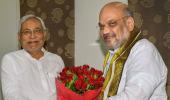While P Muralidhar Rao, BJP general secretary, says, 'Digital electioneering is here to stay until the elections in 2021,' the BJP’s rallies in Bihar will not be confined to cyberspace. Its strategists have devised other ways of getting around the hygiene protocol that Covid-19 has entailed.
Radhika Ramaseshan reports.

Union Home Minister Amit Shah’s Jan Samwad programme on June 7 for Bharatiya Janata Party leaders, office-bearers, elected representatives, and workers in Bihar marked a pivotal change in the party’s campaigning style and approach.
Shah was not present in Patna or any other Bihar town when he spoke for nearly 40 minutes. He took the mic at the party’s Delhi headquarters, appropriately masked, to signify the omnipresence of coronavirus. The Bihar contingent heard him out at the Patna office.
Although Shah maintained the public meeting had nothing to do with the Bihar elections -- scheduled to be held in November -- the thrust of his speech revealed his intent. He criticised the state’s “dynasts”, represented by Lalu Prasad and son Tejashwi Yadav, who currently leads the Rashtriya Janata Dal in his father’s absence, and talked up the Centre’s six-year “achievements”, elaborating the “special package” for migrants who travelled back home during the lockdown.
“Digital electioneering is here to stay until the elections in 2021,” said P Muralidhar Rao, BJP general secretary, adding, “In a cadre-driven party like ours, it’s vital the top leadership constantly communicates with workers through the available means.”
Sanjay Jaiswal, Bihar BJP president and West Champaran MP, was optimistic that the digital medium would be a hit in electioneering. “Our feedback from WhatsApp was that Shah’s speech reached 60,000 (of the 72,000) booths and registered 3.9 million views on Facebook and Twitter,” he claimed.
The recent data ostensibly backed the BJP’s belief that digitisation was set to catch up, if not outpace, the conventional modes of campaigning. With a young (between 18 and 23) population of 11.8 million, according to the Bihar government’s Economic Survey of 2019-20, the BJP believes its online campaign was “ripe” to capture this voting group.
A study by Kantar IMRB, a market research firm, revealed in 2019 Bihar registered the highest growth in internet users across urban and rural areas, up 35 per cent since 2018.
The Bihar online “samwad” was a “logical outcome” of an exercise the BJP began during the lockdown. J P Nadda, party president, held his first virtual conference with general secretaries. “We communicated as effectively as we did during a physical interaction,” an office-bearer said.
The process was enlarged to touch base with state presidents and their teams across the country. It travelled down the organisational hierarchy to connect with district and block chiefs and their aides so that everyone -- from the president to booth managers -- was primed with how the leadership looked at the pandemic and how it proposed to ameliorate the crisis.
It helped that the BJP -- the first political entity to embrace digitisation before the 2014 elections -- has built a 250-million strong database to the booth level with nearly 2.5 million social media volunteers.
However, the BJP’s rallies in Bihar will not be confined to cyberspace. Its strategists have devised other ways of getting around the hygiene protocol that Covid-19 entailed.
Beginning this week, two workers will approach each home in the 243 assembly constituencies, bearing the messages contained in Prime Minister Narendra Modi’s letter to the nation on completing the first year of his second term. The letter will be supplemented by a booklet that amplifies the record of the Centre, as well as the BJP-Janata Dal-United coalition government in Bihar.
Among the 21 points flagged in the 23-page booklet are the “help” extended by the Modi government to 5.2 million workers to reach their homes in Bihar in 3,840 “Shramik” trains in 25 days. The booklet also claims the March 22 “timely” lockdown helped contain the virus’s spread by 60 per cent.
But sources conceded that Chief Minister Nitish Kumar’s perceived “apathy” towards returning migrants in the initial phase of their exodus had “hurt” the BJP.
“Our party workers tried to make amends by taking our president’s call to feed migrants on the border and at the quarantine centres. We didn’t advertise our work with BJP flags because by now the people of Bihar know that in a calamity, it’s our workers who are the most active on the ground,” said a Bihar party source.
Indeed, even as the BJP is uncertain about how the present events will shape the Bihar elections, its confidence that the coalition will make it in the elections sprung from the state of the Opposition.
“Migrants will be reminded that if any person is responsible for their plight, it’s Lalu Prasad. Tejashwi was missing in action through the lockdown and is only now issuing statements. If the Opposition meets, it’s only to discuss who their leader will be,” a source said.
As the National Democratic Alliance is slated to begin talks over seat-sharing shortly, Shah iterated in his rally that the elections will be contested under Nitish’s leadership. In the bargain, he capped the speculation triggered by a remark from Chirag Paswan, Lok Janshakti Party president, who said the BJP will decide who will lead or be the face of the alliance. The LJP is the third NDA constituent.












 © 2025
© 2025